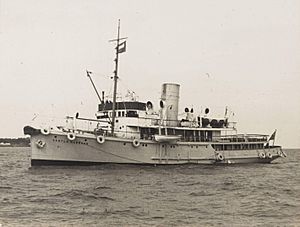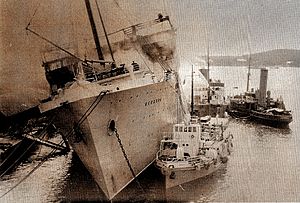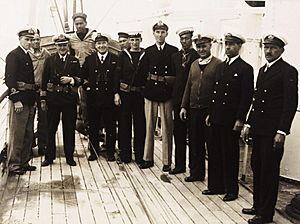HMS Castle Harbour facts for kids

Castle Harbour, prior to her armament and commissioning as a Royal Navy warship.
|
|
Quick facts for kids History |
|
|---|---|
| Name | Castle Harbour |
| Builder | Blythswood Shipbuilding Co. Ltd |
| Launched | 1929 |
| Completed | 1929 |
| Homeport | Royal Naval Dockyard, Bermuda |
| Fate | Sunk 16 October 1942 by U-160 |
| General characteristics | |
HMS Castle Harbour was a ship that started as a regular civilian boat. During World War II, the Royal Navy in Bermuda took it over. They used it to check ships coming into the harbour. Later, it got guns and became a warship. Its job was to protect the harbour from enemy submarines.
Contents
Castle Harbour: From Civilian to Warship
Early Life of the Castle Harbour Ship
The ship was built in 1929 in Glasgow, Scotland. Its first name was Mid-Ocean. It was built for a company called Bermuda and West Indies Steamship Company.
At first, some people called it a tugboat. Others said it was a tender. A tender is a boat that carries passengers between big ships and the shore. It probably did both jobs.
The ship helped passengers get to and from large Furness-Withy cruise liners. These liners traveled between Bermuda and North America. In 1930, the ship got a new name: Castle Harbour. This name honored Castle Harbour in Bermuda. A big hotel and golf course were being built there by Furness-Withy.
Fighting a Major Ship Fire
On June 17, 1931, a big fire broke out on the Furness-Withy liner MV Bermuda. This happened in the City of Hamilton. The fire was so bad it threatened to spread to buildings on shore.
Firefighters from Hamilton and the ship's crew worked together. Soldiers and marines also joined in. Sailors from the Royal Naval Dockyard helped too. They were trained to fight fires on warships. They arrived with special suits and equipment.
From the water, Castle Harbour and two Royal Navy tugs, Sandboy and Creole, aimed thirty hoses at the burning Bermuda. Another tender, the Bermudian, also came to help.
Even though it was badly damaged, the Bermuda ship was taken to Ireland to be fixed. But a second fire destroyed it there in November 1931. It was then sold for scrap metal.
Checking Ships in Wartime Bermuda
When World War II started in 1939, the Royal Navy took over Castle Harbour. It became part of the Royal Naval Examination Service (RNXS). This service checked ships arriving in Bermuda.
Ships had to stop at a place called Five-Fathom Hole. This area was just inside the outer coral reefs. From there, ships could go into St. George's Harbour. They could also follow a channel to reach the Northern Lagoon.
The Northern Lagoon led to the Great Sound. This was where the Royal Navy's main ships were anchored. It was near the Royal Naval Dockyard.
Bermuda's Important Role in World War II
The Great Sound was also used by Royal Air Force and airline flying boats. These planes landed on the water. The US Navy also started building a new air station there. This happened before the US joined the war.
During the war, Allied ships crossed the Atlantic in groups called convoys. Bermuda became a meeting point for these convoys. Many ships would anchor in the Northern Lagoon and the Great Sound. From the Great Sound, ships could also reach the main commercial port in the City of Hamilton.
All these important places could be targets for German ships or spies. The RNXS sent a naval examiner and a local pilot to each arriving ship. The pilot would guide the ship through the reefs. But only after the examiner cleared the ship could it move further in.
A place called St. David's Battery had guns ready. They would fire at any ship that tried to move without permission. Castle Harbour was used to take the naval examiner and pilot to these arriving ships. Its crew included Royal Navy members and local sailors.
Becoming a Warship: HMS Castle Harbour
As the war continued, German u-boats (submarines) became a bigger threat. So, Castle Harbour's job changed. It was refitted with weapons. It got a 3-inch gun, four machine guns, and sixteen depth charges.
Then, it was officially made a warship and named HMS Castle Harbour. Most of its crew were local sailors. Its new job was to patrol inside the reefs. It had to stop any submarine attacks. This was to prevent attacks like the one at Scapa Flow by the German u-boat U-47 in 1939. People also worried that German submarines might land spies or raiding parties.
The Loss of HMS Castle Harbour
The US military built new bases in Bermuda. The United States Army Air Forces set up Kindley Field. The US also took over anti-submarine air patrols for the UK. The US Army sent its own soldiers to Bermuda. The US Navy also sent its ships to patrol the ocean around Bermuda.
The Royal Canadian Navy (RCN) also set up a training center in Bermuda. Bermuda became a place where new US Navy destroyers and other ships prepared for battle. They practiced before being sent out.
By late 1942, many Allied anti-submarine forces were in Bermuda. This meant the threat from enemy submarines inside the reefs was much lower. So, HMS Castle Harbour was no longer needed in Bermuda.
It was ordered to go to the Mediterranean Sea. It was traveling with a group of ships called Convoy TRIN-19 from Trinidad. At 9:20 PM on October 16, 1942, a German submarine, U-160, fired a torpedo at it. The explosion broke the ship in half. It sank in just twenty seconds. Nine of its twenty-two crew members were lost.




